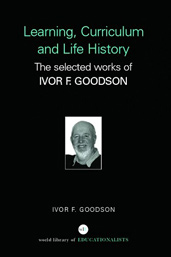Learning, Curriculum and Life Politics: the selected works of Ivor F. Goodson
On Curriculum Form
Shapin and Barnes judge therefore that "as one moved up into the higher ranks of society, one increasingly encountered more abstract, refined and complex modes of thought, and more extensive, finely structured and profound bodies of 'knowledge'." But alongside this was the requirement that knowledge should be ‘properly distributed’ not ‘improperly graded’ or taught ‘out of place’. Thus:
Properly distributed, it could operate as a symbolic display of social standing, enabling the various orders better to recognise the hierarchy and sectors to which deference was due. And it might also serve as a medium enabling communication between the top and the base of society, a vehicle through which head could control hand. Incorrectly distributed, knowledge could stimulate the masses to aspire upwards and give them the resources to use in doing so. Although, perhaps, their natural inferiority would doom these aspirations to ultimate failure, the temporary turbulence would be troublesome and inconvenient (Shapin and Barnes 1976, p. 236).
The two distinct mentalities defined for the upper and lower orders were essentially cultural resources employed in a whole range of debates and discourses.
They are a tribute to man's skill and endless creativity in the construction of rationalisations and adaptation of cultural resources to the exigencies of concrete situations. And it is as situated responses to particular polemical requirements and not necessarily as the coherent philosophies of individuals that we must treat these individuals (Shapin and Barnes 1976, p. 237).
In the process of favouring the ‘head more than the hands,’ new patterns of differentiation and examination were emerging in English secondary schooling in the mid-19th century. By the 1850s, schooling was developing links with universities through the founding of the first examination boards. Here was a structural response to the privileges of the higher orders and their allied abstract knowledge of the head. The universities of course were for ‘fine minds’ and developed curricula to ‘train the mind’. They were unequivocally for the ‘head more than the hands’, indeed ‘training the mind’ was their exclusive preserve.
The links with the social order were then clear and were often explicitly stated as the university examination boards were constructed. For instance, the University of Cambridge Local Examination Syndicate was founded in 1858: "The establishment of these examinations was the universities' response to petitions that they should help in the development of 'schools for the middle classes' " (University of Cambridge 1958). As the university examination boards came into being, a hierarchy of social orders and associated curricula were, in effect, being established and linked to a system and structure of schooling. At the top, schools were for ‘training the mind’ and developed links at the level of examinations, and at times future destinations, with the universities and with their classical curriculum. As one descended the levels of schooling, on found that the curriculum became progressively more rudimentary, was taught mechanically, and had a practical ‘orientation’.
